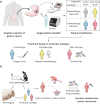Clinical Implementation of Precision Medicine in Gastric Cancer
- PMID: 31598369
- PMCID: PMC6769368
- DOI: 10.5230/jgc.2019.19.e25
Clinical Implementation of Precision Medicine in Gastric Cancer
Abstract
Gastric cancer (GC) is one of the deadliest malignancies in the world. Currently, clinical treatment decisions are mostly made based on the extent of the tumor and its anatomy, such as tumor-node-metastasis staging. Recent advances in genome-wide molecular technology have enabled delineation of the molecular characteristics of GC. Based on this, efforts have been made to classify GC into molecular subtypes with distinct prognosis and therapeutic response. Simplified algorithms based on protein and RNA expressions have been proposed to reproduce the GC classification in the clinical field. Furthermore, a recent study established a single patient classifier (SPC) predicting the prognosis and chemotherapy response of resectable GC patients based on a 4-gene real-time polymerase chain reaction assay. GC patient stratification according to SPC will enable personalized therapeutic strategies in adjuvant settings. At the same time, patient-derived xenografts and patient-derived organoids are now emerging as novel preclinical models for the treatment of GC. These models recapitulate the complex features of the primary tumor, which is expected to facilitate both drug development and clinical therapeutic decision making. An integrated approach applying molecular patient stratification and patient-derived models in the clinical realm is considered a turning point in precision medicine in GC.
Keywords: Adjuvant chemotherapy; Molecular targeted therapy; Precision medicine; Stomach neoplasm; Tumor biomarkers.
Copyright © 2019. Korean Gastric Cancer Association.
Conflict of interest statement
Conflict of Interest: No potential conflict of interest relevant to this article was reported.
Figures


Similar articles
-
Gastric Cancer in the Era of Precision Medicine.Cell Mol Gastroenterol Hepatol. 2017 Feb 20;3(3):348-358. doi: 10.1016/j.jcmgh.2017.02.003. eCollection 2017 May. Cell Mol Gastroenterol Hepatol. 2017. PMID: 28462377 Free PMC article. Review.
-
Immunomarker Support Vector Machine Classifier for Prediction of Gastric Cancer Survival and Adjuvant Chemotherapeutic Benefit.Clin Cancer Res. 2018 Nov 15;24(22):5574-5584. doi: 10.1158/1078-0432.CCR-18-0848. Epub 2018 Jul 24. Clin Cancer Res. 2018. PMID: 30042208
-
Overview of resistance to systemic therapy in patients with breast cancer.Adv Exp Med Biol. 2007;608:1-22. doi: 10.1007/978-0-387-74039-3_1. Adv Exp Med Biol. 2007. PMID: 17993229 Review.
-
Single Patient Classifier Assay, Microsatellite Instability, and Epstein-Barr Virus Status Predict Clinical Outcomes in Stage II/III Gastric Cancer: Results from CLASSIC Trial.Yonsei Med J. 2019 Feb;60(2):132-139. doi: 10.3349/ymj.2019.60.2.132. Yonsei Med J. 2019. PMID: 30666834 Free PMC article. Clinical Trial.
-
Genome-wide identification of a novel miRNA-based signature to predict recurrence in patients with gastric cancer.Mol Oncol. 2018 Dec;12(12):2072-2084. doi: 10.1002/1878-0261.12385. Epub 2018 Oct 10. Mol Oncol. 2018. PMID: 30242969 Free PMC article.
Cited by
-
EBV and MSI Status in Gastric Cancer: Does It Matter?Cancers (Basel). 2022 Dec 22;15(1):74. doi: 10.3390/cancers15010074. Cancers (Basel). 2022. PMID: 36612071 Free PMC article.
-
Updated Epidemiology of Gastric Cancer in Asia: Decreased Incidence but Still a Big Challenge.Cancers (Basel). 2023 May 6;15(9):2639. doi: 10.3390/cancers15092639. Cancers (Basel). 2023. PMID: 37174105 Free PMC article. Review.
-
Identification and Validation of an Individualized EMT-Related Prognostic Risk Score Formula in Gastric Adenocarcinoma Patients.Biomed Res Int. 2020 Mar 20;2020:7082408. doi: 10.1155/2020/7082408. eCollection 2020. Biomed Res Int. 2020. PMID: 32309437 Free PMC article.
-
Molecular target: pan-AKT in gastric cancer.ESMO Open. 2020 Sep;5(5):e000728. doi: 10.1136/esmoopen-2020-000728. ESMO Open. 2020. PMID: 32948630 Free PMC article. Review.
-
The role of senescence genes in the treatment, prognosis, and tumor microenvironment of gastric cancer.Am J Transl Res. 2023 Dec 15;15(12):6926-6938. eCollection 2023. Am J Transl Res. 2023. PMID: 38187003 Free PMC article.
References
-
- Bray F, Ferlay J, Soerjomataram I, Siegel RL, Torre LA, Jemal A. Global cancer statistics 2018: GLOBOCAN estimates of incidence and mortality worldwide for 36 cancers in 185 countries. CA Cancer J Clin. 2018;68:394–424. - PubMed
-
- Jun JK, Choi KS, Lee HY, Suh M, Park B, Song SH, et al. Effectiveness of the Korean national cancer screening program in reducing gastric cancer mortality. Gastroenterology. 2017;152:1319–1328.e7. - PubMed
-
- Kim HH, Han SU, Kim MC, Hyung WJ, Kim W, Lee HJ, et al. Long-term results of laparoscopic gastrectomy for gastric cancer: a large-scale case-control and case-matched Korean multicenter study. J Clin Oncol. 2014;32:627–633. - PubMed
Publication types
LinkOut - more resources
Full Text Sources
Other Literature Sources
Miscellaneous

